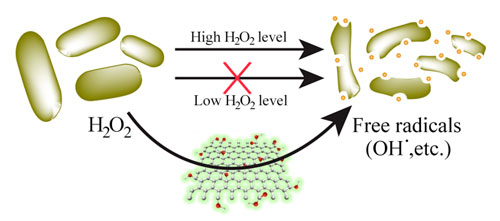| Posted: Jun 12, 2014 | |
Graphene quantum dot band-aids disinfect wounds |
|
| (Nanowerk Spotlight) A growing body of medical nanotechnology research deals with the development of antibacterial applications, ranging from nanotechnology-based approaches for diagnosing superbugs to antimicrobial surface coatings and wound treatment with antibacterial nanomaterials (Read more: "Nanotechnology solutions to combat superbugs"). | |
| Especially silver nanomaterials have been used effectively against different bacteria, fungi and viruses (see for instance: "Stamping antibacterial nanoparticles onto wounds") but also carbon nanomaterials like nanotubes (read more: "antimicrobial coating combines carbon nanotubes and natural materials") and graphene (see: "Antibacterial paper made from graphene"). | |
| In new work, researchers have now designed an antibacterial system combining graphene quantum dots (GQDs) with a low dose of a common medical reagent, hydrogen peroxide H2O2. | |
| By using GQDs, a high concentration of H2O2 – which is harmful to healthy tissue and even delays the wound healing – can be avoided for wound disinfection. With the assist of GQDs, H2O2 with a concentration that is 2~3 order lower than that commonly used, can kill bacterial effectively. | |
| "We find that the peroxidase-like activity of GQDs originates from their ability to catalyze the decomposition of H2O2, generating hydroxyl radicals," Xiaogang Qu, a professor of chemistry at Changchun Institute of Applied Chemistry, tells Nanowerk. "Since the hydroxyl radicals have a higher antibacterial activity, the conversion of H2O2 into hydroxyl radicals improves the antibacterial performance of H2O2 at low level, which makes it possible to avoid the toxicity of H2O2 at high levels in wound disinfection." | |
| Qu and his team have published their findings in the May 28, 2014 online edition of ACS Nano ("Graphene Quantum Dots-Band-Aids Used for Wound Disinfection"). | |
 |
|
| Schematic of the designed system based on GQDs and low level of H2O2 for antibacterial applications. (Image: Dr. Xiaogang Qu, Changchun Institute of Applied Chemistry) | |
| Researchers have already demonstrated that functional inorganic analogues, such as V2O5 and magnetic iron oxide, can be used to assist H2O2 for antibacterial application, i.e. killing bacteria and destroying bacterial biofilms. | |
| Qu points out that the V2O5 and magnetic iron oxide were considered to be toxic and inappropriate for the application in vivo unless via elaborate surface functionalization. | |
| "Considering the excellent biocompatibility and high peroxidase-like activity of GQDs, we conducted our work using GQDs to improve the antibacterial activity of H2O2 for the application of wound disinfection." | |
| Qu's team showed that their system provides antibacterial properties against both Gram-negative (E. coli) and Gram-positive (S. aureus) bacteria in vitro. | |
| The researchers also designed band-aids containing graphene quantum dots and found in their experiments that these GQD-Band-Aids showed excellent antibacterial property in vivo with the assistance of low concentrations of H2O2. | |
| "Our results indicate that GQD-Band-Aids have potential use for wound disinfection," says Qu. | |
| A future extension of this work could be the design of biocompatible functional nanoparticles with high peroxidase-like activity to further improve the antibacterial activity of H2O2 at low concentrations. | |
| As Qu notes, the synergy of peroxidase-like activity and other antibacterial mechanism to achieve better effect may be a particular, but promising, challenge in this field. | |
 By
Michael
Berger
– Michael is author of three books by the Royal Society of Chemistry:
Nano-Society: Pushing the Boundaries of Technology,
Nanotechnology: The Future is Tiny, and
Nanoengineering: The Skills and Tools Making Technology Invisible
Copyright ©
Nanowerk LLC
By
Michael
Berger
– Michael is author of three books by the Royal Society of Chemistry:
Nano-Society: Pushing the Boundaries of Technology,
Nanotechnology: The Future is Tiny, and
Nanoengineering: The Skills and Tools Making Technology Invisible
Copyright ©
Nanowerk LLC
|
|
|
Become a Spotlight guest author! Join our large and growing group of guest contributors. Have you just published a scientific paper or have other exciting developments to share with the nanotechnology community? Here is how to publish on nanowerk.com. |
|
